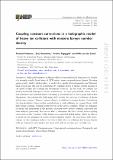| dc.contributor.author | Folkestad, Aasmund Schiager | |
| dc.contributor.author | Grozdanov, Saso | |
| dc.contributor.author | Rajagopal, Krishna | |
| dc.date.accessioned | 2020-05-19T19:56:14Z | |
| dc.date.available | 2020-05-19T19:56:14Z | |
| dc.date.issued | 2019-12 | |
| dc.identifier.issn | 1029-8479 | |
| dc.identifier.uri | https://hdl.handle.net/1721.1/125323 | |
| dc.description.abstract | Sufficiently energetic collisions of heavy ions result in the formation of a droplet of a strongly coupled liquid state of QCD matter known as quark-gluon plasma. By using gauge-gravity duality (holography), a model of a rapidly hydrodynamizing and thermal- izing process like this can be constructed by colliding sheets of energy density moving at the speed of light and tracking the subsequent evolution. In this work, we consider the dual gravitational description of such collisions in the most general bulk theory with a four-derivative gravitational action containing a dynamical metric and a gauge field in five dimensions. Introducing the bulk gauge field enables the analysis of collisions of sheets which carry nonzero “baryon” number density in addition to energy density. Introducing the four-derivative terms enables consideration of such collisions in a gauge theory with finite gauge coupling, working perturbatively in the inverse coupling. While the dynamics of energy and momentum in the presence of perturbative inverse-coupling corrections has been analyzed previously, here we are able to determine the effect of such finite coupling corrections on the dynamics of the density of a conserved global charge, which we take as a model for the dynamics of nonzero baryon number density. In accordance with expec- tations, as the coupling is reduced we observe that after the collisions less baryon density ends up stopped at mid-rapidity and more of it ends up moving near the lightcone. | en_US |
| dc.language.iso | en | |
| dc.publisher | Springer Science and Business Media LLC | en_US |
| dc.relation.isversionof | 10.1007/JHEP12(2019)093 | en_US |
| dc.rights | Creative Commons Attribution 4.0 International license | en_US |
| dc.rights.uri | https://creativecommons.org/licenses/by/4.0/ | en_US |
| dc.source | Springer | en_US |
| dc.title | Coupling constant corrections in a holographic model of heavy ion collisions with nonzero baryon number density | en_US |
| dc.type | Article | en_US |
| dc.identifier.citation | Folkestad, Asmund et al. “Coupling constant corrections in a holographic model of heavy ion collisions with nonzero baryon number density.” Journal of High Energy Physics 12 (2019): 093 © 2019 The Author(s) | en_US |
| dc.contributor.department | Massachusetts Institute of Technology. Department of Physics | en_US |
| dc.contributor.department | Massachusetts Institute of Technology. Center for Theoretical Physics | en_US |
| dc.contributor.department | Massachusetts Institute of Technology. Laboratory for Nuclear Science | en_US |
| dc.relation.journal | Journal of High Energy Physics | en_US |
| dc.eprint.version | Final published version | en_US |
| dc.type.uri | http://purl.org/eprint/type/JournalArticle | en_US |
| eprint.status | http://purl.org/eprint/status/PeerReviewed | en_US |
| dc.date.updated | 2020-03-24T17:09:51Z | |
| dspace.date.submission | 2020-03-24T17:09:54Z | |
| mit.journal.volume | 2019 | en_US |
| mit.journal.issue | 12 | en_US |
| mit.license | PUBLISHER_CC | |
| mit.metadata.status | Complete | |
